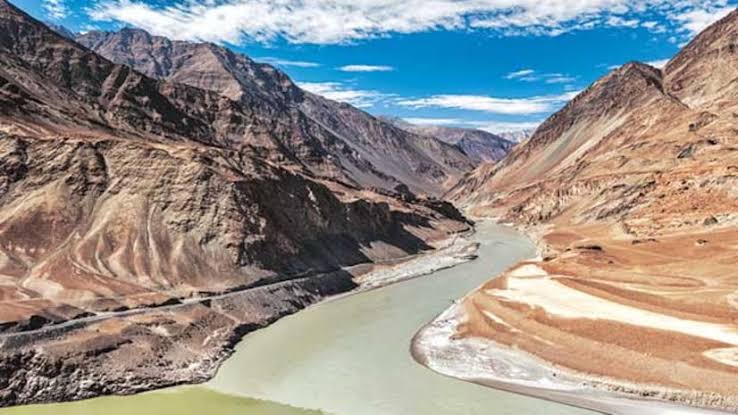What India’s Indus Waters Treaty suspension means for Pakistan?

The Indus Water Treaty was signed in 1960 after years of negotiation, with the World Bank as mediator. This Water Treaty has been one of the most durable transboundary water agreements in the world.
It divided the Waters of six rivers of the Indus Basin between the two countries. India received the three eastern rivers (the Ravi, Beas, and Sutlej). Pakistan received the three western rivers (the Indus, Jhelum, and Chenab) which account for the majority (almost 80 per cent) of the shared basin’s water.
As part of the agreement, India also retains the right to use the western rivers for non-consumptive purposes like hydropower, and for limited irrigation, but is not allowed to store or divert their flows in ways that harm downstream availability.
These factors are deliberately specific and include engineering design features and notification procedures. For Pakistan, this structure provides more than water. It provides the predictability needed to build an entire irrigation and water management system around.
The treaty also provides a standing mechanism for cooperation and conflict resolution. A Permanent Indus Commission exists, with one commissioner from each country, tasked with exchanging data, reviewing new projects, and meeting regularly.
Disagreements are resolved using a tiered process: technical questions go first to the commission, unresolved differences may be referred to a neutral expert, and legal disputes may be sent to an international Court of Arbitration, with the World Bank playing a role in both forums.
This process has been used before to resolve disagreements over India’s Baglihar and Kishanganga dams — it is designed to prevent unilateral action. Article XII says that it can only be modified by mutual agreement. That has never happened.
Though the treaty has no expiry date, and it includes no provision for suspension, it is very clear that the Treaty was concluded by two sovereign nations and any of them can take a Sovereign decision to walk out.
No third party can interfere in this or will be permitted to do so.Now India as part of its Sovereign decision has just announced that it will no longer abide by the Indus Waters Treaty of 1960, placing the agreement in “abeyance” until Pakistan, credibly and irrevocably renounces cross-border terrorism. This is a potentially historic moment.
For over 60 years, through four wars, near-conflict, and complete diplomatic breakdowns, the treaty endured. Water, unlike so much else in the India-Pakistan relationship, had remained predictable. That predictability is now ended.
The decision potentially marks a turning point in how the two countries manage the most essential shared resource between them. There will be many other discussions in the days ahead that dwell on geopolitics. So what will be the implications for Pakistan’s rivers, crops, people, and policymakers?
What matters most in the days and months ahead is not a sudden cut-off which is not possible geographically ko, but the erosion of reliability of a water system that millions depend on every single day.
The Indus, Jhelum, and Chenab are enormous rivers. Between May and September, as snow melts, these rivers carry tens of billions of cubic meters of water. India has some upstream infrastructure on these rivers, including the Baglihar and Kishanganga dams, but none of it is designed to hold back these kinds of volumes.
These are run-of-the-river hydropower projects with very limited live storage. Even if India were to coordinate releases across all its existing dams, all it may be able to do is slightly shift the timing of flows.
The overall volumes in the western rivers during this high-flow period are far too large to meaningfully disrupt without flooding its own upstream regions. India already utilises most of the flow from the eastern rivers allocated to it under the treaty, so any new actions on those rivers would have a more limited downstream impact.
However in the dry season when the flows across the basin are lower, storage matters more, and timing becomes more critical. That is where the absence of treaty constraints could start to be felt more acutely.
So it is clear that presently India cannot simply “stop the flow” of water into Pakistan. In the immediate term, certainly not at the scale that would make a meaningful dent in flows during the high flow season.
Over the medium to longer term, the picture becomes more complicated. If India chooses to act outside the treaty framework, it opens the door to developing new infrastructure that would give it greater control over the timing and volume of flows into Pakistan.
But even then, the path is far from straightforward. Any large-scale dam or diversion project would take years to build. The sites available in Jammu & Kashmir for significant water storage are limited and geologically challenging.
The financial cost would be enormous. There are also hydrological constraints. Holding back high flows on rivers like the Chenab or Jhelum risks flooding upstream regions in India itself. And the idea of diverting water out of the Indus Basin entirely, into other parts of India would require enormous infrastructure and energy costs that would be hard to justify, even in peacetime.
While the physical limits on disruptions by India are real, the erosion of treaty protections still matters. This is not because water will stop tomorrow, but because the system it supports for Pakistan was never built for uncertainty.
The flows of the Indus, Jhelum, and Chenab are the backbone of Pakistani agriculture, Paki cities and Paki energy system. At this moment, they simply do not have a substitute for these waters.
For Pakistan, the impact of India’s disruption (if manifested) could be far-reaching. Pakistan’s irrigation system is one of the largest in the world, depends almost entirely on the predictable timing of flows from the western rivers.
Farmers plan their sowing around those flows. Canal schedules are designed based on assumptions that have held for decades. If that rhythm is even slightly disrupted, the water system will begin to fray.
The most immediate risk is to predictability. Even if the total volume of water coming into Pakistan does not change immediately, small changes in when that water arrives can cause real problems.
A late-season delay during the wheat planting cycle, or an unexpected dip in flow during the dry winter months, can mean missed sowing windows, lower yields, and higher costs. The Indus Delta is already shrinking due to reduced freshwater outflows.
Further uncertainty in upstream flows could accelerate that degradation, with consequences for coastal livelihoods and fisheries.
Any shortfall or shift in river timing will force the Pakistani Provinces to make hard choices about water allocation. This risks intensifying inter-provincial tensions, especially between Punjab and Sindh, where water-sharing debates are already politically charged.
Then there’s energy. A third of Pakistan’s electricity comes from hydropower, generated by water flowing through Tarbela, Mangla, and other reservoirs. If upstream flows are reduced or poorly timed, it could cut into generation capacity. None of this is speculative.
Pakistan is already a water-scarce country, living close to the edge. A system that has long been run on thin margins now faces a new layer of uncertainty.
While the Indus Waters Treaty has long been praised for its durability, the last decade full of mounting strain. In 2013, a Court of Arbitration ruled in Pakistan’s favour by requiring India to release minimum environmental flows downstream of the Kishanga.
Next came the project (upstream on Jhelum), and set limits on reservoir drawdown. This successful resolution was a continuation of the treaty’s ability to manage complex engineering disagreements.
But that pattern began to shift after the 2016 Pak supported Terrorists attack in Uri. India suspended routine cooperation, and began fast-tracking dam projects it had long delayed, and started linking water to broader Paki narratives of providing support to terror.
Even then, India said it would work “within the pact.”Next came the dastardly Pulwama attack and all bets were off. However there were other pressing priorities.
Then in 2023, when India formally invoked Article XII(3) (the provision that allows for treaty modification only by mutual consent) and requested renegotiation, citing climate change, national development needs, and Pakistani obstruction.
Pakistan refused to renegotiate. World Bank was told to lay off by India in no uncertain terms.India then pursued a neutral expert to review technical dam design questions; Pakistan pushed ahead with a Court of Arbitration.
By early 2025, both mechanisms were active in parallel; this is something the treaty never envisioned. India has now suspend its obligations under the treaty and it marks the culmination of a long, escalating trajectory in face of continued suport of Pakistan to terror groups.
What comes next will test not just bilateral diplomacy, but will make World see India’s resolve to eradicate the terror ecosystem from inside Pakistan itself.
The Indus Waters Treaty is not perfect. But it does something few agreements between adversaries manage to do. It keeps the rivers flowing and gives both countries a reason to keep talking, even when everything else has broken down.
That framework is now under strain. Whether the treaty is reinstated in full, renegotiated, or left to fade in practice, what follows will be harder.Now even small projects can lead to panic in Pakistan.
Every monsoon, every reservoir, every dry spell may become a potential source of tension. At a time when climate change is already intensifying droughts and floods, and when Pakistan is facing rising domestic water stress, the last thing the region needs is another layer of uncertainty.
The western rivers are not just shared rivers. They are Pakistan’s primary source of water. In the long run, there may be reforms or alternatives. But in the here and now, there is no substitute.
These rivers sustain lives, livelihoods, and landscapes across the country. Pakistan can simply not afford to antagonize India any more. Thus, the flows must continue for Pakistan. Stopping them are like strangling the jugular vein of Pakistan.
The Indus and its tributaries that have sustained civilisations for thousands of years, now test the capacity of Pakistan to cooperate and eradicate its terror ecosystem totally. The coming months and years will reveal whether wiser heads prevail in Pakistan.
Pakistan has started threatening that any attempt by India to construct major new storage on the western rivers would be viewed as an act of war.
Well now India is ready to eradicate Terrorism once for all …even if it means WAR.




